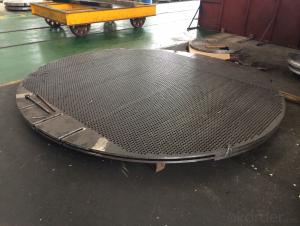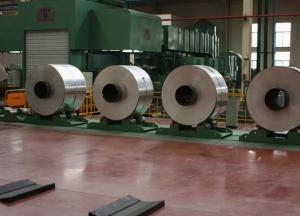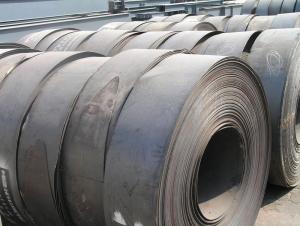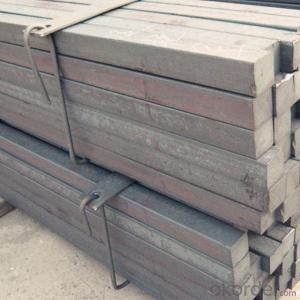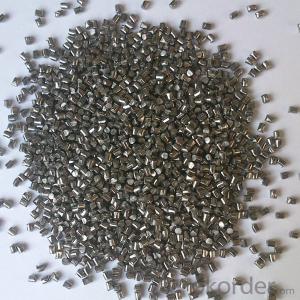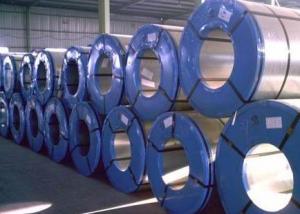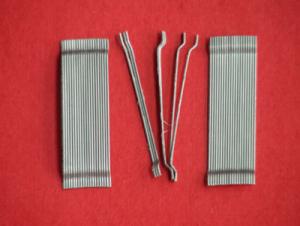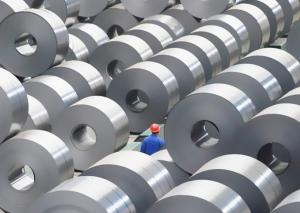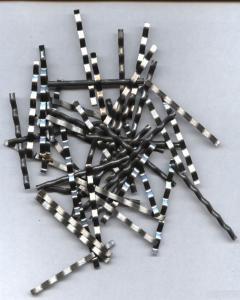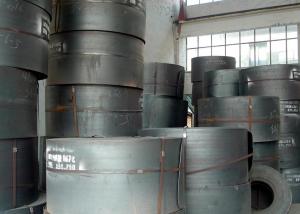Tube plate
- Loading Port:
- China Main Port
- Payment Terms:
- TT OR LC
- Min Order Qty:
- -
- Supply Capability:
- -
OKorder Service Pledge
OKorder Financial Service
You Might Also Like
Tube plate is drilled in circular steel tube outer diameter slightly larger than the same hole, will penetrate into the welded pipe fixed, play a role of such accessories
Tube sheet machining accuracy, especially the tube hole spacing and diameter tolerance, verticality, smoothness affect listed above are assembled and using performance of chemical equipment. With large-scale chemical equipment, power plant, the tube plate diameter becomes larger and larger, diameter of tube plate of 4m-5m is very common. Characteristics of large tube plate tube holes number, density, small pore size, depth, accuracy and high fineness
According to the needs of the different use of the environment, the use of different materials, container board generally use Q345R, such as class one or two pressure vessels, non corrosive medium circulation, use carbon steel composite plate. Encountered strong, high pressure and high temperature, such as nuclear power environment requires the stainless steel, 16 manganese, corrosion resistant titanium alloy materials, application of new synthetic materials, to bring new life to the tube plate products
For tube plates of three or four types of pressure vessel needs high precision hole machining, the traditional method is fitter, rocker drilling drilling. In recent years, with the large-scale chemical container, the diameter of the tube plate is also increasing, the thickness is gradually thickened, processing of tube sheets also introduced the NC technology, now in general use NC drilling machine hole guiding with the rocker drilling hole machining. Using the processing center to do the processing for high efficiency and high precision holes have gradually been accepted by some large enterprises. At present, large thick tube sheet in nuclear power, desalination, and central air-conditioning heat exchanger area needs a growing trend
- Q:How is steel used in the manufacturing of household appliances?
- Steel is commonly used in the manufacturing of household appliances due to its durability, strength, and heat resistance. It is used to construct the outer bodies, frames, and interiors of appliances such as refrigerators, ovens, dishwashers, and washing machines. Additionally, steel is also used in the production of various components, including panels, shelves, racks, and internal structures, ensuring the appliances can withstand the demands of daily use while providing a long-lasting and reliable product.
- Q:What are the uses of steel grating in walkways and platforms?
- Steel grating is commonly used in walkways and platforms due to its various benefits. It provides a sturdy and durable surface that can withstand heavy foot traffic and loads. The open design of the grating allows for efficient drainage, preventing water accumulation and reducing the risk of slips and falls. Additionally, steel grating offers excellent visibility and ventilation, making it suitable for outdoor and industrial environments. It is also resistant to corrosion, making it a long-lasting and cost-effective solution for walkways and platforms.
- Q:How is steel used in the production of electrical appliances and wiring?
- Steel is commonly used in the production of electrical appliances and wiring as it provides a strong and durable framework for various components. It is often used in the construction of appliance casings, motor housings, and brackets, ensuring the safety and protection of internal electrical components. Additionally, steel is used in electrical wiring as a support structure, providing strength and stability to carry and distribute electricity effectively.
- Q:What are the different types of steel fencing and barriers available?
- There are several types of steel fencing and barriers available, including chain-link fencing, ornamental steel fencing, palisade fencing, welded wire mesh fencing, and steel crowd control barriers.
- Q:What are the different types of steel tanks and their applications in the chemical industry?
- There are several different types of steel tanks commonly used in the chemical industry, each with its own specific applications. Some of the most common types include carbon steel tanks, stainless steel tanks, and alloy steel tanks. Carbon steel tanks are widely used due to their affordability and strength. They are suitable for storing non-corrosive chemicals and are often used for petroleum products, water, and certain acids. Stainless steel tanks are known for their superior corrosion resistance and durability. They are commonly used for storing corrosive chemicals, such as acids, alkalis, and solvents. These tanks are also suitable for hygienic applications in the food and pharmaceutical industries. Alloy steel tanks are designed to withstand high pressures and temperatures. They are often used for storing reactive chemicals, such as hydrogen, ammonia, and chlorine. These tanks are also used in processes that require high strength and resistance to corrosion. Overall, the choice of steel tank in the chemical industry depends on the specific application, the properties of the chemicals being stored, and the required levels of corrosion resistance, strength, and durability.
- Q:What are the common types of steel products used in the chemical industry?
- Some common types of steel products used in the chemical industry include stainless steel pipes, tanks, and vessels, as well as steel valves and fittings. These steel products are chosen for their corrosion resistance properties, as they need to withstand harsh chemicals and environments.
- Q:How is steel used in the production of elevator systems?
- Steel is used extensively in the production of elevator systems due to its strength, durability, and reliability. It is used for constructing the elevator shaft, frame, and car, providing structural support and ensuring the safety of passengers. Steel is also used for manufacturing various components such as guide rails, doors, and counterweights, contributing to the smooth operation and efficient functioning of the elevator system.
- Q:How do steel products contribute to the agriculture and farming sector?
- Steel products contribute to the agriculture and farming sector in several ways. Firstly, steel is used in the manufacturing of machinery and equipment essential for agricultural activities, such as tractors, combines, plows, and irrigation systems. These machines help increase efficiency, reduce labor, and improve productivity on farms. Additionally, steel structures, such as barns, silos, and storage facilities, provide durable and secure spaces for storing crops, livestock, and equipment. Steel is known for its strength, durability, and resistance to weather conditions, making it ideal for protecting agricultural resources. Furthermore, steel is used in the construction of infrastructure such as bridges and roads, which play a crucial role in connecting farms to markets and facilitating the transportation of goods. This infrastructure ensures that agricultural products can reach consumers in a timely and efficient manner. Overall, steel products contribute significantly to the agriculture and farming sector by enhancing productivity, providing storage solutions, and supporting the necessary infrastructure for the smooth functioning of the industry.
- Q:What are the different types of steel rails and their applications?
- There are several types of steel rails commonly used in various applications. Some of the most common types include: 1. Light rails: These rails are typically used in light-duty applications, such as tramways, narrow gauge railways, or temporary tracks. They are relatively lightweight and offer flexibility for installation and maintenance. 2. Heavy rails: Heavy rails are designed for high-load applications, such as mainline railways or heavy industrial tracks. They are more robust and can withstand heavy traffic and large loads over long distances. 3. Crane rails: These rails are specifically designed for crane tracks and overhead cranes. They are constructed to handle the dynamic loads and stresses imposed by cranes, ensuring smooth movement and stability. 4. Grooved rails: Grooved rails are commonly used in urban transit systems, such as trams or light rail vehicles. They have a groove along the top surface that guides the wheels, providing additional stability and preventing derailments. 5. Flat-bottomed rails: These rails are widely used in standard railway tracks. They have a flat base that rests on the sleepers, providing stability and support for heavy trains. Flat-bottomed rails are typically used in mainline railways and high-speed tracks. 6. Switch and crossing rails: These rails are used at railway switches and crossings, where trains can change tracks or cross paths. They are designed with specific profiles to ensure smooth transitions and safe operations for trains. The applications of these steel rails vary depending on the specific type and its characteristics. However, they are crucial components in the construction of railway systems, tramways, industrial tracks, and crane tracks, providing the necessary support and stability for efficient and safe transportation of goods and passengers.
- Q:What are the applications of steel mesh in security fencing?
- Steel mesh has various applications in security fencing due to its strength, durability, and versatility. It is commonly used in high-security areas such as prisons, military installations, and sensitive government buildings. Steel mesh provides a physical barrier that prevents unauthorized access, deters intruders, and enhances the overall security of the premises. Additionally, its transparency allows for better visibility, making it suitable for areas where surveillance is crucial. Overall, the applications of steel mesh in security fencing help safeguard properties, protect assets, and ensure the safety of individuals within the enclosed area.
1. Manufacturer Overview |
|
|---|---|
| Location | |
| Year Established | |
| Annual Output Value | |
| Main Markets | |
| Company Certifications | |
2. Manufacturer Certificates |
|
|---|---|
| a) Certification Name | |
| Range | |
| Reference | |
| Validity Period | |
3. Manufacturer Capability |
|
|---|---|
| a)Trade Capacity | |
| Nearest Port | |
| Export Percentage | |
| No.of Employees in Trade Department | |
| Language Spoken: | |
| b)Factory Information | |
| Factory Size: | |
| No. of Production Lines | |
| Contract Manufacturing | |
| Product Price Range | |
Send your message to us
Tube plate
- Loading Port:
- China Main Port
- Payment Terms:
- TT OR LC
- Min Order Qty:
- -
- Supply Capability:
- -
OKorder Service Pledge
OKorder Financial Service
Similar products
New products
Hot products
Related keywords
